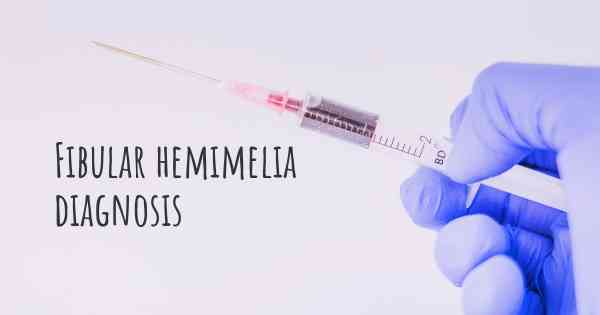How is Fibular hemimelia diagnosed?
See how Fibular hemimelia is diagnosed. Which specialists are essential to meet, what tests are needed and other useful information for the diagnosis of Fibular hemimelia

Diagnosis of Fibular Hemimelia
Fibular hemimelia is a rare congenital condition characterized by the partial or complete absence of the fibula bone in the leg. It is typically diagnosed shortly after birth or during early childhood. The diagnosis of fibular hemimelia involves a comprehensive evaluation of the patient's medical history, physical examination, and various imaging techniques. Early detection and accurate diagnosis are crucial for appropriate treatment planning and management of this condition.
Medical History
The first step in diagnosing fibular hemimelia is obtaining a detailed medical history of the patient. The healthcare provider will inquire about any family history of similar conditions, previous pregnancies, and any known genetic disorders. Additionally, they will ask about the presence of any associated symptoms or abnormalities, such as limb length discrepancy, foot deformities, or gait abnormalities. This information helps in understanding the context and potential causes of the condition.
Physical Examination
During the physical examination, the healthcare provider will carefully assess the affected leg and foot. They will observe for any visible abnormalities, such as shortened or curved leg, foot malformations, or differences in leg length. The range of motion of the hip, knee, and ankle joints will be evaluated. The presence of any associated conditions, such as clubfoot or knee instability, will also be assessed. The physical examination provides valuable initial clues for the diagnosis of fibular hemimelia.
Imaging Techniques
Imaging plays a crucial role in confirming the diagnosis of fibular hemimelia and providing detailed information about the extent of the condition. The following imaging techniques are commonly used:
1. X-ray:
X-rays are often the first imaging modality used to evaluate fibular hemimelia. They provide detailed images of the bones and can reveal the absence or underdevelopment of the fibula bone. X-rays also help assess the alignment of the leg bones, joint structures, and any associated skeletal abnormalities. The healthcare provider may take X-rays from various angles to obtain a comprehensive view of the affected limb.
2. Ultrasound:
Ultrasound imaging may be used in infants to assess the soft tissues, blood vessels, and joint structures. It can help identify any associated abnormalities, such as vascular anomalies or joint dislocations. Ultrasound is particularly useful in evaluating the hip joint and detecting any dysplasia or instability.
3. Magnetic Resonance Imaging (MRI):
MRI provides detailed cross-sectional images of the leg, allowing for a comprehensive evaluation of the bones, muscles, tendons, ligaments, and other soft tissues. It can help assess the presence of any associated anomalies, such as abnormal muscle insertions or joint abnormalities. MRI is especially valuable in preoperative planning and determining the optimal treatment approach.
4. Computed Tomography (CT) Scan:
In some cases, a CT scan may be performed to obtain detailed three-dimensional images of the leg bones. CT scans can provide additional information about the bony structures, joint alignment, and any associated skeletal abnormalities. They are particularly useful when surgical intervention is being considered.
Genetic Testing
In certain cases, genetic testing may be recommended to identify any underlying genetic abnormalities or syndromes associated with fibular hemimelia. This can help determine the cause of the condition and provide valuable information for genetic counseling.
Consultation with Specialists
Given the complexity of fibular hemimelia, it is often necessary to involve a multidisciplinary team of specialists in the diagnosis and management. Orthopedic surgeons, pediatricians, geneticists, and radiologists collaborate to ensure an accurate diagnosis and develop an appropriate treatment plan tailored to the individual patient's needs.
In conclusion, the diagnosis of fibular hemimelia involves a thorough evaluation of the patient's medical history, physical examination, and various imaging techniques. X-rays, ultrasound, MRI, and CT scans are commonly used to confirm the diagnosis and assess the extent of the condition. Genetic testing may be recommended in certain cases. Early and accurate diagnosis is essential for effective treatment and management of fibular hemimelia.








